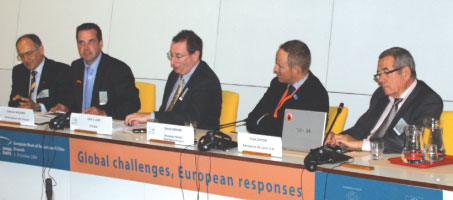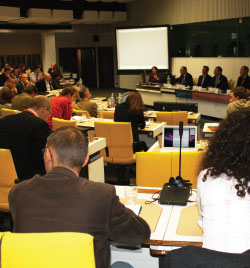 The potential of airports to aid economic and regional regeneration is widely recognised. Airports can be the single largest employer in a region, with a wide range of employment types, and can be the catalyst for inward investment. The latest ACI EUROPE statistics for the year to September show that, while traffic recovery is likely to be slow, low-cost carriers are helping to generate passenger growth in some locations. Some airports handling fewer than five million passengers per year recorded encouraging year-on-year growth in September, including Brussels South Charleroi (+40.3%), Bologna (+20.1%) and Cagliari (+18.8%).
The potential of airports to aid economic and regional regeneration is widely recognised. Airports can be the single largest employer in a region, with a wide range of employment types, and can be the catalyst for inward investment. The latest ACI EUROPE statistics for the year to September show that, while traffic recovery is likely to be slow, low-cost carriers are helping to generate passenger growth in some locations. Some airports handling fewer than five million passengers per year recorded encouraging year-on-year growth in September, including Brussels South Charleroi (+40.3%), Bologna (+20.1%) and Cagliari (+18.8%).
This seventh edition of the Open Days consisted of 125 seminars, workshops, debates and exhibitions between 5 and 8 October, attracting more than 6,000 participants. It was standing room only in the ACI EUROPE/SMAG Workshop, which attracted more than 100 attendees, and took place as part of ‘The Meeting Place’ – a platform for connecting Open Days participants, particularly from regional and local public authorities and the private and financial sector.
The Workshop was moderated by Eliot Lees, VP, SH&E, who directs SH&E’s finance and airport privatisation practice. He led a distinguished panel comprising Tonci Peovic, CEO, Zagreb Airport and SMAG vice chairman; David Gering, commercial director of aviation, PR & communication, Brussels South Charleroi; Yves Guyon, Président du Directoire, Aéroports de Lyon; and Andrew Holding, community affairs manager, Birmingham International.
Lees opened with a message that, in the current economic climate, airports have to realistically assess the market in which they operate. “There are no easy solutions. Airports need to think about their market, revenues and cost – all of these areas are going to become increasingly important,” he said.
Rail will be important to how SMAG airports plan for the future. “Rail will probably take a bigger share from certain metropolitan-located airports, as operators benefit from EU deregulation and infrastructure improvements,” said Lees. “You have to understand if rail will have a significant impact in your market. The first priority is to define or fine-tune your strategic plan, and to understand the existing and potential strategic role of your airport.”
There are no easy solutions moving forward and the four solutions put forward by Lees are essentially good business practices: “Understand emerging airline market trends, keep costs low, maximise revenues, and better understand your customers.”
He emphasised the potential of low-cost services to SMAG airports, as it is the low-cost carriers that are expanding their fleets and they need to put these new assets to use. “This translates into opportunities for airports,” said Lees. “There are 178 small and medium size airports with no low-cost services today. LCCs are building up their fleets and need to find new destinations. You need to understand how to attract them.”
Listening to your passengers
Tonci Peovic, CEO, Zagreb Airport and SMAG vice chairman, opened with some statistics: There are 605 airports in Europe – only 35 of those handle more than five million passengers per year and they account for 79% of passenger traffic; the remaining 570 airports handle fewer than five million passengers and account for 21% of traffic. “The impact of the recession on SMAG airports means double trouble – declining aeronautical revenues and declining commercial revenues,” said Peovic. “There are increasing capital costs – access to capital markets is difficult and privatised airports are potentially more exposed. Increasing shareholder pressure means publicly-owned airports are potentially more exposed, while there is also increasing airline pressure to decrease charges.”

Andrew Holding, community affairs manager, Birmingham International: “Our citizens need greater connectivity to realise the potential that lies in the region. Connectivity is how we see our role in driving the regional economy.”
He outlined some specific characteristics of regional airports: Costs are constant and depend on aircraft type and operating hours; there are huge differences in national regulations; exposure to oscillations in traffic in peak season, meaning revenue is limited to peak times; and strong pressure from airlines regarding pricing policies.
“For the sake of a sustainable airport network in Europe, don’t forget that one mile of road takes us nowhere, but that one mile of runway takes us everywhere,” concluded Peovic.
The Brussels South Charleroi story over the last 10 years makes for fascinating reading. 10 years ago the airport was handling fewer than 200,000 passengers; this year it will handle close to four million. The name change to Brussels South Charleroi occurred in 1997 and Ryanair really put the airport on the map in 2001, when it chose to base aircraft there and launch 12 routes. That was followed by the arrival of Wizzair in 2004 and work on the new terminal began in 2005. The terminal opened last year, with a capacity of three million. Significantly, 2007 saw the arrival of Private Wings – a specialist business carrier. This, explained David Gering, commercial director of aviation, PR & communication, “shows the impact of listening to your passengers and what they want. We are a regional airport that can cater for business passengers,” said Gering. “We have flexible, low-cost operations and a 25-minute turnaround. We are also ready for the future – there is space for two planned extensions in the coming years.”
The future looks as exciting as the last 10 years have been for Brussels South Charleroi. It is partly-privatising this year, with a 27% stake being sold to Italy’s SAVE Group; 2010 will see an extra 1,500 parking spaces ready before the start of the summer season, construction of a terminal extension will begin, and a forecast 700,000 additional passengers will be handled; throughput is expected to reach 10 million in 2015; and a dedicated railway station is planned for 2016.

More than 100 attendees packed the room for the ACI EUROPE Workshop, which focused on the role of airports as key engines of economic growth. They heard insightful presentations from four airports: Zagreb, Brussels South Charleroi, Lyon and Birmingham International.
Greater connectivity
Aéroports de Lyon operates a multi-modal airport system, with Lyon-Bron airport catering for general aviation and complementing the main Lyon-Saint Exupéry airport. “Today, we have a diversified and balanced portfolio of traffic – a complete airport system,” said Yves Guyon, Président du Directoire, Aéroports de Lyon.
In economic terms, Lyon is France’s second largest city; 12% of national exports are from the region and it ranks seventh in Europe in terms of GDP. “Our residents have a comfortable disposable income, which makes them frequent travellers. There are six million inhabitants in the region,” said Guyon.
Aéroports de Lyon currently handles eight million passengers per year, with a well-balanced portfolio of leisure and business traffic. Passenger numbers increased 8.2% in 2008. €50 million has been invested in the airport infrastructure since 2007 and Aéroports de Lyon has more than 900 hectares of land reserves, which will enable it to construct a new runway to meet demand.
Birmingham International Airport celebrates its 70th Anniversary this year and also recently opened its new International Pier. The airport is situated in a region traditionally known for its manufacturing industry, but the economy is diversifying to include the hi-tech and service sectors. It is a changing region and a region of great diversity. “Our citizens need greater connectivity to realise the potential that lies in the region. Connectivity is how we see our role in driving the regional economy,” said Andrew Holding, community affairs manager, Birmingham International.
In order to achieve this connectivity, the airport needs to extend its runway and there are plans for a 400m extension to 3,000m. The current effective range is to the east coast of the US and towards south Asia; the extension would enable services to the US west coast and the Far East. “It is a relatively modest extension that will bring the connectivity the region really needs,” said Holding. “We have received planning permission and are ready to go subject to finance – it is a £110 million (€120m) investment. The extension will bring us an additional four million passengers by 2013 (throughput is currently 9.2 million). 400m of runway will bring the West Midlands to the world – it is absolutely crucial. We currently only serve three of the world’s 20 fastest-growing cities – the 400m extension will change that.”
Positioned for future growth
Each of these case studies demonstrates the potential of Europe’s small and regional airports. While it is a difficult time for airports, as well as economies, these examples show that they can position themselves for future growth. Concluding the Workshop, Lees stated that airports need to fine-tune their business strategies to reflect a realistic assessment of their market opportunity. LCCs, he said, will continue to drive growth for the next 5-10 years and that presents opportunities for small and regional airports. “Because of economic recession, demand has been pushed back by two to three years, according to economists. Airports, airlines and the whole industry needs to deal with that. In one way it’s a problem; in another it’s a chance for industry to regroup and think how we move forward,” said Lees.
Building on the success of the Open Days Workshop, ACI EUROPE holds the 3rd SMAG Conference and Exhibition in Dubrovnik, 15-17 March 2010.







